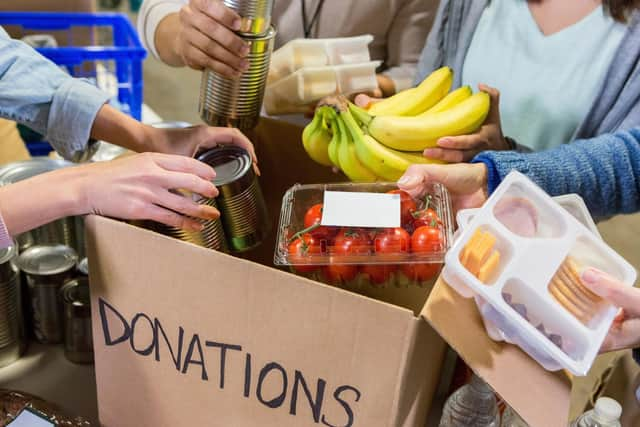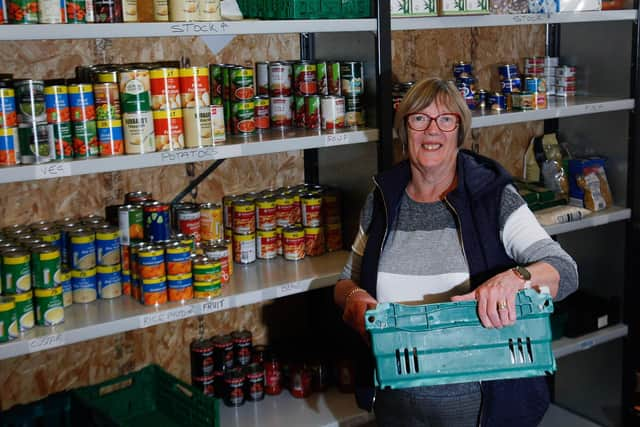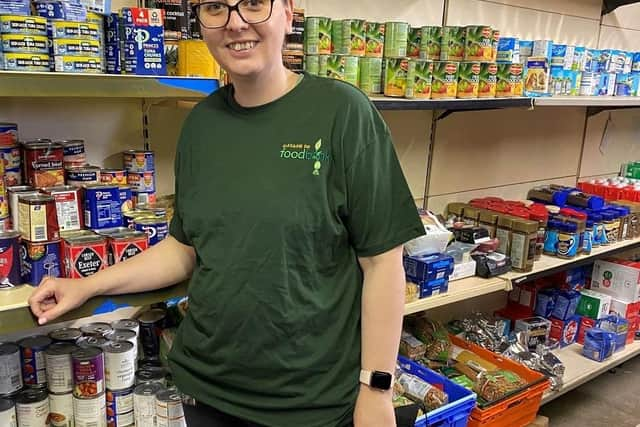'I don’t see how this model of food aid can continue' - Food banks forced to cut services as rising demand meets falling donations
In the nine years since it was founded with the aim of ensuring no one in the Fife town goes hungry, the charity is now eating itself. With increasing numbers of people coming through its doors, falling donations, and spiralling food prices, it is dealing with a growing deficit and is burning through its reserves at pace.
“We have some very difficult decisions to make,” admitted Joyce Legatte, one of the food bank’s board members. “But if we don’t make them, we’ll be non-existent. That’s the bottom line.”
Advertisement
Hide AdAdvertisement
Hide AdWhile rising inflation and the deepening cost of living crisis are sending increasing numbers of Scots into poverty, it is also having a ruinous impact on charities and community organisations striving to help the poorest.
With the prices of essential items such as rice and pasta rocketing, the food bank in Kirkcaldy is now spending over £20,000 a month on produce. The problem is that its annual income only stands at £150,000, down more than half on the previous year.
An already significant monthly deficit is widening every month. At the same time, food donations from members of the public are down around two thirds year-on-year. It is, as Ms Legatte puts it, a “perfect storm”.
“Something’s going to have to go, whether it’s the amount of food we give to people, the variety of options, I’m not sure,” she said. “The way things are, we’re looking at our reserves lasting under 12 months.”
The question of what that means for the food bank’s clients is one that should occupy the thoughts of those in local and national governments.


The prospect of scaling back the service comes at a time when it has never been needed more. With 1,460 visits, April was the second busiest month in its history, and more than a third of those visits were by families. The numbers for May and June are still being crunched, but the queues outside are as stark a sign as any of how things are getting demonstrably worse.
“We’re seeing a lot more older people who can’t cope on state pensions, and we’re seeing people we haven’t seen for a couple of years,” said Ms Legatte, a former NHS midwife. “They’ve been just getting by, but they can’t any longer.”
Similar trends are being felt at food banks the length and breadth of the country, with others forced to scale back the help they can offer.


Advertisement
Hide AdAdvertisement
Hide AdIn Aberdeen, the Instant Neighbour charity has been providing emergency food parcels to individuals in serious need for over 20 years. How much longer it can do so is open to question.
Due to spiralling food prices and a 50 per cent year-on-year drop in donations, it has been forced to reduce the size of its parcels in the hope of ensuring its growing numbers of clients receive some help.
Whereas the charity was receiving around seven tonnes of food a month from FareShare at the height of the pandemic, it is now lucky if it gets a tonne. It means that outgoings are up, and the trend cannot continue indefinitely.
“The last thing we want to do is turn people away because we don’t have food, but we’ve seen a 30 per cent increase in clients since April, and where once a £500 food shop would have filled our Transit van a year ago, now it barely fills a quarter of it,” explained Evan Adamson, who runs Instant Neighbour’s food bank and offers welfare advice and referrals.


“It’s the price of basics like rice, pasta, bread, and sauces that’s massively risen, and it’s even worse with the likes of tinned macaroni, hot dogs, or tuna.”
With inflation forecast to increase, and energy prices set to spike yet again in October, Mr Adamson believes the future for food banks are bleak at a time when they are in unprecedented demand.
“I don’t actually see how this model of food aid can continue beyond this year,” he said. “We’re a reasonably big food bank in a big city that sees 150 to 200 households a week, but as things stand, we need the public to come up with £3,000 a week to help with our costs. By October, that could reach £4,000 or £5,000 a week. In reality, we’re getting £1,800 to £2,000.
“We’re seeing far more employed people suffering from food poverty, and workers in the gig economy are a massive part of it, but the demographic changes all the time. I’ve had half a dozen people from one of the wealthiest areas in Aberdeen contact me in the last month.
Advertisement
Hide AdAdvertisement
Hide Ad“These are families who work hard, have a nice house, a nice car. One had a household income of around £60,000 to £70,000 a year, but with the cost of living, they don’t have anything left after paying their bills.”
Edinburgh City Mission, which runs a network of food banks across seven sites, is spending around £1,000 a week on ‘top up’ food to make up shortfalls in provision. It too, is encountering greater need, with the number of guest visits in April to June projected to be 31 per cent up on the same period last year. Between January and March the increase was 17 per cent.
“The cost of living is putting pressure on the volunteer teams across our network,” said Duncan Cuthill, the mission’s CEO. “We’re extremely grateful for their hard work and commitment.”
In the relatively prosperous commuter town of Helensburgh, demand is also up, with a significant drop-off in donations.
“During Covid we were seeing around 40 people a week, but last week, we had 72,” said Mary McGinley, chair of Helensburgh and Lomond Foodbank. “We’re seeing more families, and in all but two months since October, we’ve been receiving less than we’ve given out.
“The combination of the higher food prices and fuel is shocking, and my concern is the impact it has on volunteers. It all adds to the complexity of being a simple food bank, and I fear it will become unsustainable.
“Charitable food aid cannot in any way bridge the gap between the low incomes people are suffering from, and the poverty that’s becoming endemic. The problem has to be addressed upstream.”
In Scotland’s biggest city, the demographic changes in food bank users are also acute. Claire McCunnie, manager of the Glasgow South West Food Bank, which runs three services in the city’s Ibrox, Mosspark, and Cardonald areas, said she has never seen such desperation in the nine years she has been running the service.
Advertisement
Hide AdAdvertisement
Hide AdHer clients span generations and backgrounds, from asylum seekers who have only been in Scotland for a few weeks, to those in the twilight of their lives left unable to make ends meet. One of her regulars is an 84 year-old man, a fact which angers Ms McCunnie. “No one that age should be forced to rely on food banks,” she reflects.
Over the past two or three months, she had noticed a shift in the make-up of her service users.
“There are a lot more families coming in, and families who live in bought houses. It’s not just folk in tenements,” she explained. “Both parents might be working full-time, but once they’ve paid their mortgage and bills, they literally don’t have anything left.”
More people are seeking food that can be prepared without a cooker, sometimes known as ‘kettle boxes’, to save on energy costs. “It’s not just that people can’t afford food, they can’t afford to cook it,” Ms McCunnie added.
Her primary concern is what will happen come October, when the energy price cap rises, and the long winter that will follow.
“I can’t stand to think about it,” she said. “There was a time a few years back when I thought the need for food banks might disappear, but no, not now. There’s not even a glimmer of light at the end of the tunnel.”
Sabine Goodwin, co-ordinator of the Independent Food Aid Network, said the crisis facing so many food banks underscored the need for political action.
"Independent food banks are running out of road,” she stressed. “It's essential that both the UK and Scottish governments do all they can to immediately tackle the root causes of rapidly growing poverty and destitution.
“Relying on overburdened volunteers to help people pushed into poverty as a result of governmental inaction is unsustainable, ineffective, and unconscionable."
Comments
Want to join the conversation? Please or to comment on this article.
